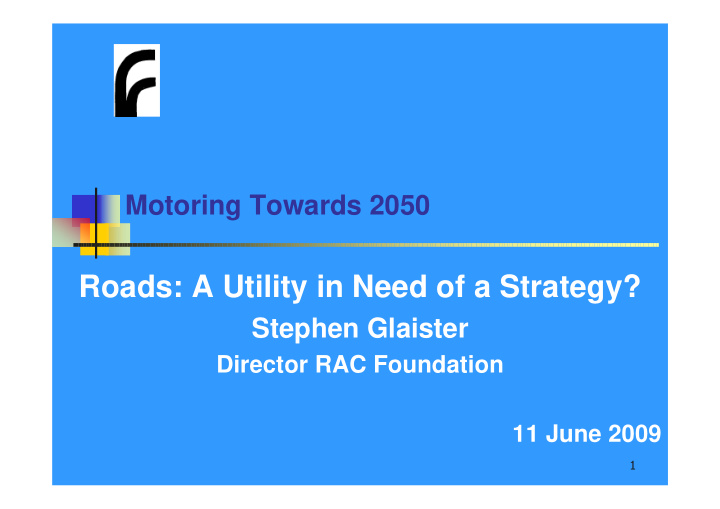



Motoring Towards 2050 Roads: A Utility in Need of a Strategy? Stephen Glaister Director RAC Foundation 11 June 2009 �
Relentless road traffic growth (source: Road Statistics 2007, DfT) ��������������������� �
Predictability of journey times As the network gets closer to capacity Average journey times increase (classic congestion) Variability of journey times increase. Conventional appraisal has only considered the average Eddington, DfT research have recognised this ��������������������� �
National Traffic Forecast (DfT, 2008) ��������������������� �
It will get much worse? Between 2005 and 2041: � Population will grow by at least 11% � Most growth in the E, S and London � Incomes will double � Number of cars will increase by 44% � Road traffic demand up by 43% (RAC Foundation estimates) But Will economy recover? Telecoms and IT? �
What to do? Nothing? Improve public transport? Taxes and charges? More capacity? better management more physical infrastructure
Public transport cannot help much Public transport improvements may be good policy BUT They cannot make much impact on road congestion or carbon emissions at a cost that is feasible Rail and local bus each have 6% of passenger market
Plans to 2015 January 2009, � Hard shoulder running alternative to motorway widening, � 520 additional lane miles to the national strategic road network, 340 lane miles through hard shoulder running. � £6bn announced in July 2008 � Not much new capacity for local roads?
Timescales for construction are long! Crossrail opens in 2017 High Speed Rail open well after 2020 We live today with decisions made in 1990’s … on rail and road All the political parties are talking very long term on rail very short term on road!
Timescales for management changes are much shorter Maintenance Variable message signs Traffic officers Managed Motorways Speed control But all these measures require increased, continuous funding of operating expenditure
Investment good value for money? Sector Number of projects Average Benefit: cost Highways Agency 93 4.7 Local Road 48 4.2 Local Public Transport 25 1.7 Rail 11 2.8 Light Rail 5 2.1 Walking and Cycling 2 13.6 Total 184 Source: Eddington (Dodgson, RAC Foundation ,2009)
Appraisal methods subject to revision …but economic returns look very good for the right schemes (Eddington)
Is Carbon a show stopper? Budget 2009: Official Carbon Budgets Transport emissions stable
Picture is of more traffic Stable transport carbon emissions Achieved by improved vehicle technology etc. Implication: we will need more road capacity!
Is it “affordable”?
What we pay for our roads GB Roads: taxes (ex VAT) and government spending (2006 prices) 35 Local roads National roads 30 Other taxes 25 £ billion 20 Fuel duty 15 10 5 0 1975 1981 - 82 1986 - 87 1996 - 97 2006 - 07 ��������������������� ��
But what are these charges for?? � Demand management? � Environmental charges? � General revenue raisers?
Under any Government Reality is that they will remain or increase as general revenue raisers
National Road Pricing A means to manage demand more efficient use of existing network A way of generating more funds in order to emhance the network
How roads are administered The DfT strategic development, policy and funding. The Highways Agency delivery and management for the strategic road network. Regional Development Agencies (RDAs) develop regional transport plans. Local authorities responsible for local transport policy and maintenance of local road networks. HMT collects road tax: separately determines national and local spending
Problems in roads Byzantine confusion about who is accountable for what The absence of a customer billing relationship between the service provider and the road user No independently reported measure of quality of service No independent consumer protection No long term strategy
For Rail there is now a coherent strategy High Level Output Specification (HLOS) Statement of Funds Available (SoFA) Independent Regulator to adjudicate that it all adds up High speed rail proposals will have to be shown to be good value for money vs the alternatives, � genuinely good environmentally � affordable by the taxpayer �
This rail regime aligns predicted numbers of users � charges to users � sources of funds (fares, taxes) � investment in capacity � Similar for all the other regulated utilities (but not roads!)
Can roads progress without reform?? Taxes and charges? level and structure Institutions and governance?
Like other regulated utilities? Road infrastructure provider With an income stream � Held accountable by independent regulation � A duty to meet the needs of users � Ensure that it is able to finance its functions � Monitor its performance in relation to stewardship and service � delivery; and
Conclusions � Do nothing?? � Highways Agency given [what?] corporate status � An independent regulator for roads and road safety? � Government HLOS and SoFA for roads? � Informed by input from road users, local authorities and regional bodies?
Better output & Q of S measures and associated reporting systems A customer representation body for road users? to include commercial road users? Financing of the Highways Agency: providing a revenue stream independent of DfT
Regional Planning input? Interface with local authorities? New Planning Act and statement of national need?
We need a long term strategy for our roads!
Recommend
More recommend